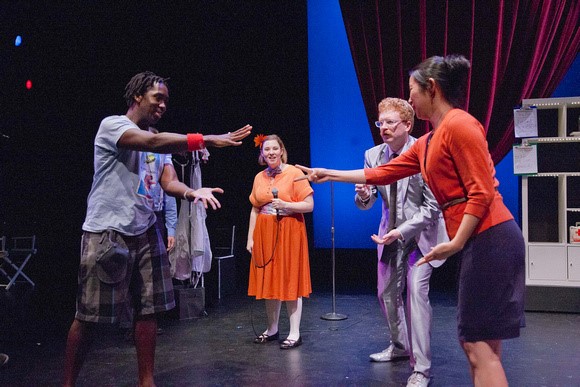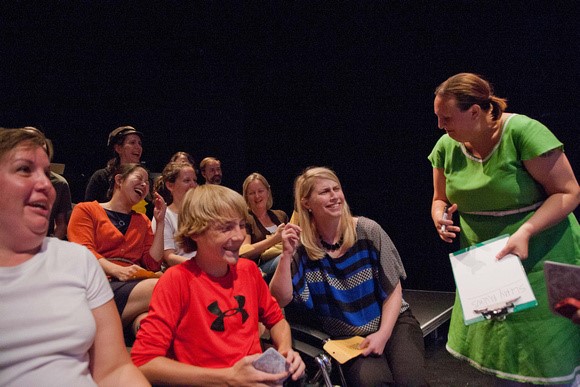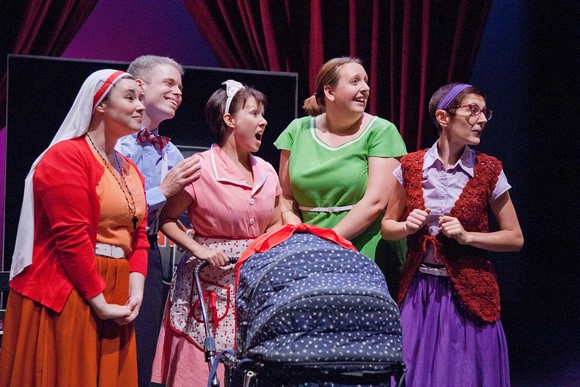When Dog & Pony DC premiered A Killing Game in 2012, both the company and its audiences were in for something new. Dog & Pony DC, a small theatre company in Washington D.C., encouraged audiences to direct the plot and influence characters using Twitter. Through 10 Twitter handles, one hashtag, calls, and texts, every audience member became a resident in A Killing Game’s small Midwestern town. Using this technology audiences and actors stood side-by-side, immersing themselves in a collaborative artistic experience
In order to learn more about the company’s decision to utilize social media and its approach to integrating the technology and management of its uses, AMT Lab’s Kristen Sorek West spoke to company director, Rachel Grossman. Ms. Grossman provided great insight into staging a successful social media infused theatrical performance:
- Managers should build for themselves opportunities to revise the execution and use of social media. This process will not only allow the manager to refine the process, but also learn through doing.
- Create a culture around the social media, rather than treating the social media as an afterthought.
- When introducing a new element, like social media, anticipate the need to educate your staff, cast, and audience on both the practical execution as well as the artistic concept.
- Social media is a great tool to engage hesitant audiences. Using social media, managers can create a range of activities that give audiences the power to choose how much they want to participate.




All images courtesy of Dog & Pony DC.
The full interview is below. For further reading on Dog & Pony DC’s work in developing immersive theatre experiences, please click here.
KSW: Why did Dog & Pony decide to incorporate social media into A Killing Game?
RG: The deeper concept when creating A Killing Game was to explore the hype that was developing around public health scares and crises. Traditional news sources reported these scares, however news was also spreading across social media, which at this point has now become a critical thread in our news cycle.
Around the time Dog & Pony was developing A Killing Game Twitter was getting a bad reputation for being an unreliable news source. Twitter users were reporting news from different news sources and retweeting those tweets with amended commentary, creating more and more distance and disparity between the Twitter content and the original source content.
Our show combines these elements together: a plague that is killing people and no one can figure out what’s going on.
We also wanted to create new ways for audiences to interact with the performance, and find new points of accessibility. The environment that Twitter creates is more physical, less observational, and more casual, allowing audiences to feel more comfortable participating.
KSW: Audience members participated in the performance using only one social media channel, Twitter. Why was Twitter chosen? Why not Facebook, or another social media channel?
RG: Twitter is a conversation-based platform while Facebook is more of an interactive scrapbook. On Facebook users post images and comments, but users are not responding in the minute. Facebook users are effectively checking in to catch-up. On Twitter users are having back and forth conversations whereas Facebook is merely hosting it.
We wanted to create a new level of audience integration – those who may not feel comfortable participating on stage may feel comfortable tweeting. Over the course of the show this type of participation expanded to texts and calls. We try to scaffold the experience, interweaving the audience into the fabric of the show by building an environment where everyone is capable of participating according to their own personal level of comfort. Not only were we able to flesh out the narrative we wanted to tell on stage using social media but could use this technology to add a new dimension to the audience’s experience.
KSW: What other factors helped enable this project? (Available space, funding, willing staff, etc.)
RG: There was no additional monetary cost to us to incorporate Twitter into A Killing Game. Twitter is free, there were no additional audio or visual equipment necessary to implement using Twitter on stage. Our staff is also more game and willing to experiment by nature. We also knew what the experiment was and had a clear idea of what we wanted to achieve so made that made things easier, too. We did reach out to social media communications professionals for assistance. We asked if there were alternative social media platforms the staff wasn’t familiar with to consider but it was generally agreed that Twitter was the correct medium to use.
KSW: Were these social media communications professionals friends or hired professionals?
RG: They were friends already.
KSW: Did you survey audiences to see if they had a preferred social media channel?
RG: It was not necessary to ask audience in this instance because Twitter was already determined to be critical to the piece.
KSW: Were there any audiences that felt distracted by trying to follow both Twitter and the show simultaneously?
RG: Yes, there were some comments from audience members who felt distracted, especially in the first run, but that was due to how the show was initially constructed. In the first version, in the second scene of the show there was a four-minute scene of stylized movements, between characters over Twitter and a series of news casts, where the audience hears announcements of the plague getting worse. The scene was interesting but it did not invite audiences to use or participate on Twitter. We should have taken own advice and stayed true to how we wanted to interact with audiences.
That being said we are intentionally asking audience members to focus on one story at a time, either the one on stage or the one on Twitter. We are big believers in asking audiences to split their focus. We are not asking the audiences to look at everything because gets messy, only one channel is possible.
KSW: What was the role of Twitter in the performance?
RG: The audience could tweet at the different characters on stage and each character had their own Twitter handle. Overall there were 10 handles and one hashtag.
KSW: How were all of those Twitter accounts managed during the performance?
RG: Dog & Pony has a Gmail account and all of the Twitter accounts were linked to that Gmail account. During the very first performance all of the accounts were overseen by the stage manager. However, in the first run that proved to be too much work for one person. If you want social media to be present in your programming you have to have a person who present with that social media.
After the first run we created the role of social media conductor for the show - one person to respond to all tweets, text messages, and calls during the show. Early on the company members traded the responsibility. You were on a computer for the length of the show, but it was fun to have very long conversations with audience members. Also, each handle had its own persona so whomever was behind the computer was acting through the Twitter handles. When writing for 10 different personas you have to know how to craft language and use different voices in writing. It took the social media conductor in Cleveland a few shows to really hit her stride. If you were tweeting original content you also had to think about what you could create relating to the show that would get audiences both in the theatre and following at home to respond. This approach helped to create a larger community and a sense of interconnectedness with people not just in the room.
KSW: Did you use a website or application to manage the Twitter handles?
RG: The social media conductor used Tweet Deck to juggle all of the Twitter handle conversations. We used Tweet Deck, rather than Hootsuite, purely because of familiarity. The company members knew how to navigate the application and felt comfortable with it.
KSW: Is it important for the person dedicated to the social media in the performance be a part of the project from conception?
RG: The first stage manager who handled the social media during the show was a part of developing the role of social media for A Killing Game. Later, after the role of social media conductor was created, the conductor did some rehearsal prep and wrote a script for the social media but ultimately you can’t know what it’s like until actually running the show. Because social media is the product of social engagement you can’t know what it will be like until it’s in front of the audience. Until that point, the show isn’t complete.
Initially we pre-wrote the tweets, scripting everything that was supposed to happen and then we gave that script to the stage manager. But by doing that we broke our cardinal rule: we were foolish to assume that if we threw tweets out at people they would automatically be engaged. Overall, we rewrote the social media component, interweaving Twitter through the entire performance, and expanded the participation capabilities to include calling and texting. Also, in case there were audience members who wanted to participate on Twitter but who didn’t have a Twitter account, we created shadow account that audience members could use.
KSW: Did audience members use the shadow account?
RG: Not really. Audience members instead just asked for assistance in setting up their own Twitter accounts so we had to teach staff how to teach audience members to create Twitter accounts.
KSW: Which staff members did you have to educate?
RG: We had to teach cast members how to both interact and guide audience members in opening up Twitter accounts in character, and on both Androids and iPhone. We had to teach the cast members because starting with the first show audience members would ask the box office staff and volunteers for assistance, but they have other jobs to do.
KSW: How long did it take to teach the cast members the best methods to guide audiences in creating new accounts? How many cast members were doing this each performance?
RG: The education session lasted about an hour. We had about 6-7 cast members available every show, for audiences between 70-100 people.
KSW: Earlier you mentioned that Dog & Pony had the opportunity to reformat the show and also let the social media conductor adjust her methods over time. What if an organization has limited opportunities to refine their social media implementation and execution practices?
RG: If you don’t have the opportunity to learn from your mistakes and then apply those lessons then it seems like a bad experiment. Change the scenario to give yourself opportunities to refine your approach and use the technology again. You have to create conditions that will allow you to be successful but also that will allow you to learn. Don’t pursue a project that is too massive. Create realistic goals that you can learn from. Know your equipment, your personnel, and your creativity capacity. Ask yourself, “What are we capable of doing? What impact do we want, and how will we measure that impact?” Then, “What happened? What did we learn and what will we do differently next time?” Managers should build in that educational framework and iterative process for themselves, especially if they’ve never done taken on a challenge like this before. By doing so, not only are you learning from this experiment, but you are also keeping your work fresh for yourself.
KSW: Did you experience any resistance from members of the organization? What about donors or visitors?
RG: There were some people who were resistant but they were not company members, board members, or visitors. Visitors, more often than not, know what they are getting into when they come see one of our shows. Dog & Pony’s board is very familiar with the company’s mission to push boundaries and perform experimental work. Although they are a reflective and questioning group, they were very encouraging.
KSW: What do you wish you would have known prior to starting the project?
RG: I wish I had known more about the Twitter application at the time. Sometimes, if searching for a particular hashtag, the search results would only return some of the tweets. At the time, Twitter divided tweets into two groups, ‘All Tweets’ and ‘Some Tweets.’ By default Twitter would only show the ‘Some Tweets’ group so Twitter wouldn’t show us our full audience participation. Now if you perform the same search you get to choose which group of tweets you want to see.
Consequently, we conducted a lot of problem solving on our end. We tried to figure out what we were doing wrong, not knowing that the problem was with the application itself. We ended up recommending third party application to our audiences, Tweetcast. Now we don’t need the third party application because Twitter has fixed that setting.
KSW: Was there anything that surprised you about this project; difficulties, audience reaction, press coverage?
RG: People really like taking pictures of each other. It was a lot of fun to see pictures of the actors in the show and other moments of the show. Seeing all of these pictures wasn’t necessarily surprising but delightful. Also, audiences taking pictures during the show turned out not to be distracting to performers or the other audience members. The act of taking a picture is not really that distracting when there is already so much going on.
KSW: What advice would you give managers interested in incorporating social media into their programming?
RG: Managers have to learn how to build the culture, the environment of social media around the organization, event or series. You have to grow and shape the culture to work with social media. Also, social media is there to be used all the time not just while in office and, with so many participants, it does mean that you will lose a little bit of control, but you’re opening yourself up to so many more possibilities.
KSW: Would you consider A Killing Game to be successful in its use of social media? How has doing this show impacted your upcoming work?
RG: We are really pleased with how it turned out, and we are continually refining it. Our upcoming show, Toast, uses almost no technology in it, and the next few shows don’t either. The shows don’t incorporate social media because it’s not a critical function driving the show. Choosing to use social media in a production is about examining how that social media relates to the work generated.

